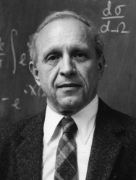Roy Glauber

Photon Interference
I have a weakness in my left eye, and recently was sitting in my ophthalmologist’s office getting my eyes examined.
A technician was discussing with his colleague how to record the results of one of the measurements, and they decided to express
the answer in diopters.
Well that was very informative to the patient!
In optics, diopters are a mathematically convenient method of expressing the focal length of a compound lens.
So, I at least could make an educated guess as to why I had been asked to peer into one end of the ophthalmologist’s device while
he, on the other end, was bringing into focus an image of a cross. I surmised that my eye and the device formed a compound lens, and using the known focal
length of the device, he could calculate the focal length of my left eye’s lens (assuming he could get a sharp enough image).
One of the benefits of a scientific education is you can bring to your ailments a detached attitude. I remember that Enrico Fermi, when he was
sick and dying of cancer (due to the exposure to radiation in his work, presumably), took meticulous notes of his condition because
he thought they could be useful to his and future doctors.
So the trip to the ophthalmologist got me thinking about optics, which in turn reminded me of the work of the great Roy Glauber, who got his Nobel for work in
quantum optics. While Glauber's work in quantum optics is well known, he also authored an incredibly insightful, (albeit seldom mentioned), letter in the American
Journal Physics which clarified a mistaken claim sometimes made about photons -- that photons interfere with themselves.
The incorrect notion that a photon interferes with itself is often found in books on quantum computing.
Photon interference is used to illustrate how interference in quantum mechanics differs from the classical case.
Fair enough, but as stated most incorrectly state that a photon can interfere with itself, and one book gets even weirder by saying
that it is the photon paths that interfere.
Evidently, none of the physicist authors or co-authors were aware of Roy Glauber's
January 1995 letter to the editor in
the American Journal of Physics which clarified photon interference once and for all. I now partly quote from Glauber's letter:
Glauber first identifies the source of the confusion, the great Dirac:
"The source of trouble is a statement by Dirac...'Each photon interferes only with itself. Interference between two different photons can never occur.'"
And Glauber ends by summarizing what really happens:
"The things that interfere in quantum mechanics are not particles. They are probability amplitudes for certain events.
It is the fact that probability amplitudes add up like complex numbers that is responsible for all quantum mechanical interferences.
When the event in question represents the detection of a single photon, one can easily slide into the statement that the photon is interfering with itself. When one deals, on the other hand, with two-photon states, one still encounters many species of interference effects, but it would generate intolerable confusion to interpret these photons as interfering with one another. It is not difficult, for example, by means of non-linear optics, to construct situations in which interference takes place between an amplitude for a single blue photon and an amplitude for another state with two red photons. Quantum mechanics allows such interferences and a great many other varieties as well, but no one could sensibly speak of photons as interfering with themselves or any others in that sort of context.
To sum it all up, these three papers are out in left field. It is time to put the famous dictum to rest,
to remember Dirac and to honor him for his wonderful contribution to physics, and to forgive him for writing
down in the early days of quantum mechanics a highly simplistic remark which has sowed confusion among physicists ever since"
Enough said. Photons do not interfere with themselves, no matter how many quantum computing books claim otherwise.